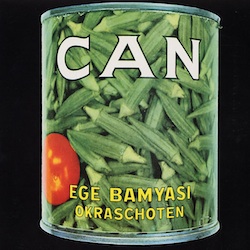Krautrock: Can, Ege Bamyasi (1972)
Even the band’s most ardent fans forget (or ignore) the full title of this one -- “Ege Bamyasi Okraschoten.” They also either disagree or never bother to figure out how to pronounce it. As far as I’ve been able to tell, “bamyasi” is Turkish for okra while “ege” alludes to a company from Istanbul that among other things canned vegetables. Whatever you call it, “the one with a can of okra” deserves a spot near the top of any discerning listener’s Krautrock rankings.
Contrasting with the epic that preceded it (Tago Mago), Ege Bamyasi presents a (relatively) less freaky selection of seven accessible tracks, even producing a top 10 single in Germany. While lead singer Damo Suzuki would stick around for one more album before departing the group, Cope nonetheless regards Ege Bamyasi as “the only true Damo Suzuki/Can album” given the turn toward more instrumental, prog-like music subsequently produced by the band.
A short burst of feedback heralds the opening track, the nine-plus minute “Pinch.” It’s a highly funky, Electric Miles era-type groove over which Suzuki improvises nonsensical word associations (in English). “Sing Swan Song” follows, the sound of running water giving way to a soft, lullaby-like tune that gradually fades up to reveal what sounds a bit like an incantation amid its many layers of effects-laden guitars. By contrast, the driving “One More Night” closing out the first side features crisper-sounding clarity, with harmonics propelling the tune forward not unlike an Eno-era Talking Heads track.
Side Two begins with a moody number titled “Vitamin C” in which Suzuki enigmatically croons to someone about losing his or her vitamin C (a symbol for strength?). The track throbs along, giving bassist Holger Czukay lots of room to caper about, before finally resolving into the uncanny electronic warbling that becomes the next dish, the ten-plus minute “Soup.” After a few minutes of percussive head-bopping, “Soup” slips back into the avant-garde, with an extended sequence of weird chirrups, crashes, sirens, and shouting.
All is made nice again, though, with “I’m So Green,” a track whose super catchy, toe-tapping vibe evokes thoughts of a band of hipsters sneakily sauntering down some trippy sidewalk. The LP then concludes with “Spoon” -- the hit single -- which begins with metronome-like clicking over a vaguely Eastern sounding organ, then builds into yet another fun, trance-like slice of Krautrockin’ pop.
It’s “the closest to a pop LP that Can ever got” writes Cope, a record full of “clear cut songs with grooves of delightful melody and moment, plus a teen-appeal that still leaves me gasping with love for Damo Suzuki.” Partly for that reason, it’s the Can album I’ll often recommend as a starting place for those new to the group.
It also culminates the middle “classic” period of Can records, the “late” period commencing with Future Days (1973) and including Soon Over Babaluma (1974), Landed (1975), Flow Motion (1976), Saw Delight (1977), Out of Reach (1978), and Can (1979) -- the discs I probably spin the most from the band. From there the band split, then reunited with original vocalist Malcolm Mooney for a one-off reunion disc, Rite Time (1989).
Sadly drummer Jaki Liebezeit passed away just last Sunday at age 78. In addition to serving as a core member of Can throughout its run, Liebezeit performed and recorded with numerous other acts over the decades including various side projects by Can members, Jah Wobble, and Michael Rother. He also notably helped percussively-push along the tiny, crowded canoe in Brian Eno’s “Backwater” from Before and After Science.
Here is a nice remembrance of Liebezeit from The Guardian detailing his achievements and remarking on Can's important place in the larger musical landscape.
Meanwhile, crack open this Can and enjoy:




Comments